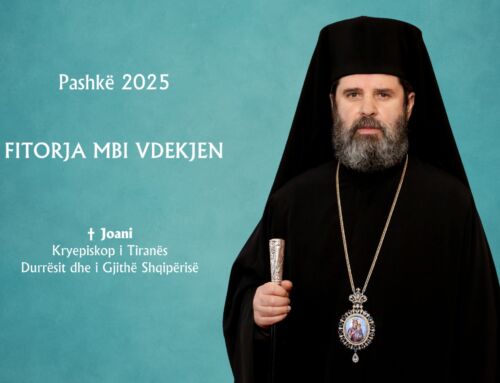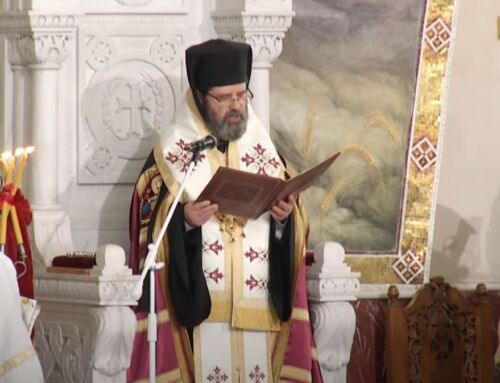End of the Icon Debate
Following the council of 787 at which the veneration of the holy icons was formally defended in the Church, new imperial rulers emerged who once again attacked both the veneration and the venerators of the holy images. When the Empress Irene died in 802, Leo the Armenian became the emperor. In 815 he ordered the icons in the churches to be placed beyond the reach of the faithful so that they could not be honored and kissed. On Palm Sunday in 815, Saint Theodore, the abbot of the great Studion Monastery in Constantinople, led a public procession with the holy icons. This procession was met by imperial attacks, tortures, and murders. Only in 842, with the ascendancy of the Empress Theodora, under the leadership of the Patriarch Methodius, were the holy icons returned once and for all to the Church. This formal return of the icons on the First Sunday of Lent in that year marked the beginning of the annual celebration of the Feast of the Triumph of Orthodoxy still observed today.
Cyril and Methodius – The Mission to the Slavs
In the middle of the ninth century the patriarch of Constantinople, Saint Photius, sent missionaries into Moravia to bring the Christian faith to the Slavic people. The Greek brothers, Constantine and Methodius, arrived in Moravia in 863. Constantine had already created the Slavic alphabet – now called the Old Slavonic or Old Bulgarian – which the brothers used to translate church books into the Slavic language. Their work consisted of teaching the alphabet, introducing the liturgical books and ritual, and training men for the priesthood.
The mission of Constantine and Methodius created hostilities with the Frankish missionaries from the Latin Church who had come to Moravia earlier. They believed that the official languages of the Church should be Hebrew, Latin, and Greek only. They did not believe that the Slavic language should be used in the Church services. Thus Constantine and Methodius went to Rome in 869 to justify their work, particularly the use of the native language in the liturgy. Pope Hadrian II blessed the Greek missionaries for their work.
Constantine died in 869. Just before his death he became a monk, taking the name of Cyril by which he is known as a saint of the Church, and from which his alphabet received the name Cyrillic.
Methodius was consecrated as the archbishop of Pannonia. When he returned to his missionary work, he was arrested by the Frankish-Germanic clergy with the help of Louis the German. In 873 when Pope John discovered what had happened to Methodius, he demanded his release. But, the Roman Church was unwilling to press too hard on this issue for fear of offending the rapidly growing Frankish and Germanic powers. Methodius died in 885 with his work all but totally ruined, as a result. Most of his disciples were arrested, exiled, or sold into slavery. Some escaped into Bulgaria where Saints Clement and Naum did great missionary work among the people there. The Bulgarians by this time were receiving the Christian faith. They had been attached to the Church of Constantinople in 870. The work of Saints Cyril and Methodius, the “evangelizers of the Slavs,” continued on from Bulgaria through the Serbian lands, and ultimately into Kiev and Northern Russia in subsequent centuries.
The Filioque Issue
The clash between the East and the West was not only over the mission to the Slavs. It had deeper roots in the role which the new Frankish and Germanic rulers were to play in Western Europe and in the Western Church.
In the year 800, on Christmas Day, Charlemagne was crowned emperor by the Pope of Rome. In 792 this new ruler had already sent his Carolingian Books (Libri Carolini) to Pope Hadrian I. The reason for Charlemagne’s attack against the Eastern Church was that this was the only way in which he could discredit the Eastern emperor so that he himself could be recognized as the sole ruler in Christendom. In his vision of the new Holy Roman Empire Charlemagne wanted to include all of the East together with all of the West.
In 808 Pope Leo III of Rome reacted against the charges of Charlemagne against the East. He had the creed without the filioque enshrined in golden tablets on the doors of St. Peter’s.
The Papacy
Although Charlemagne’s attempts to establish rule over all Christendom did not succeed, the Roman popes began to extend their churchly governance over the, whole of the West. By the middle of the ninth century, Pope Nicholas I (858-867) succeeded in gaining direct control over the entire Western Church by suppressing the local metropolitans and making all bishops in the West directly subject to the Roman see. He also referred to the False Decretals, documents later proved to be forgeries, which claimed that the Emperor Constantine in the fourth century had given certain powers and privileges to the Roman bishops. It was claimed that the powers included secular control over territories around Rome which later came to be called the papal states. This was the so-called Donation of Constantine.
Photius, Patriarch of Constantinople
From 861-886 the first open clash took place between the Eastern and Western Churches. In Constantinople there were two political parties struggling for power.
To settle a dispute between these two parties and to provide a church leader which both groups could respect and would accept, a layman named Photius was elevated to the partriarchal office. Although Photius was the one candidate upon whom both parties could agree, the extremists of the so- called conservative party were not satisfied. They appealed to Rome, using the good name of the former patriarch Ignatius – who had peaceably retired for the good of the Church – against Photius and the imperial government which confirmed his election. Pope Nicholas seized the opportunity of this extremist appeal to interfere in the affairs of the Constantinopolitan Church, calling a council in that city in 861 to settle the dispute. When the papal legates came to the council they saw that Photius was the rightful patriarch, and all was happily settled. However, when the legates returned to Rome, Pope Nicholas rejected their decision, and held another council, this time in Rome in 863, at which he proclaimed Ignatius as the bishop of Constantinople, thus deposing Photius. His actions were ignored.
In 866 and 867 the Bulgarian Church was fluctuating between Constantinople and Rome. In 867 Photius and a council of five hundred bishops in Constantinople condemned Pope Nicholas for interfering in the affairs of the Bulgarian Church. In this same year there was another internal political conflict in Constantinople. When Basil I became emperor, Photius resigned as bishop for the sake of unity. For political reasons Ignatius was reinstated. In 869 Pope Hadrian II, the successor of Nicholas, excommunicated Photius again for his role in the Bulgarian affair. In 877 Photius, who was not in disfavor with the new emperor, again became patriarch when the venerable Ignatius died.
In 879 a huge council took place in Constantinople, once again with papal legates in attendance. At this council, presided over by Photius, the traditional privileges of the Pope of Rome in the East were clarified by Photius and accepted by John VIII who was the new pope. The councils of 863 and 869 which condemned Photius were declared null and void. The council of 787 was accepted as the seventh ecumenical council. The creed was affirmed without the filioque.
Photius was officially canonized a saint by the Orthodox Church in the tenth century. He was a man of many talents. He was a great theologian who wrote extensively, particularly on the question of the filioque by defending the procession of the Holy Spirit from the Father alone. He was a compiler of classical and patristic writings. He sponsored the mission to the Slavs. He defended the authentic Church Tradition in confrontation with the Roman claims invented by Nicholas, while ultimately preserving unity with the Roman Church and Pope John VIII. He was an excellent diplomat in political affairs, with personal humility and wisdom which earned him the respect of good-willed persons of all parties in East and West. Saint Photius was one of the truly great bishops in Christian Church history.
Liturgical Developments
In the ninth century another great saint, Saint Theodore of Studion was responsible for liturgical development. Saint Theodore was the abbot of the Studion monastery in Constantinople who had, during his lifetime, about a hundred thousand monks in his charge. He is known for his defense of the holy icons, and for his role in the development of Orthodox liturgical worship. The liturgical typikon, the order public worship in the Studion monastery, has become the normative order of worship for the entire Orthodox Church since the ninth century. The service books for Great Lent and Easter, the Lenten Triodion and the Flower Triodion (also called the Pentecostarion) are almost totally the work of the Studite monks, among the most famous of whom is Saint Joseph the Hymnographer.
Also dating from the ninth century is a copy of the Divine Liturgy of St. John Chrysostom which has the liturgy of the faithful in virtually the exact same form in which it is done in the Orthodox Church today.
Law Code
At the end of the ninth century the famous law code called the Epanagoge was published by the emperor Basil I. It reaffirmed the system of the “symphony” or unity between the church and state.
The West
Generally speaking, the ninth century was one of the most significant centuries in Church history. It was a period of renaissance in the East, while in the West it was one of increasing centralization around the Roman papacy. The only theologian of note in the West at this time was John Scot Erigena (d.877), who brought the strong influence of the Eastern theology of Dionysios and St. Maximus into the Western Church.


